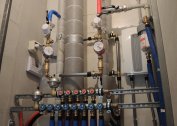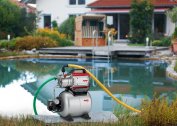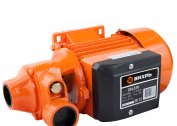Centralized water supply consists of an infrastructure complex of intake stations and treatment facilities, distribution networks and pipelines. The health and life expectancy of people depends on the quality of the water used, therefore SanPiN for water supply was developed, where hygienic standards for safe characteristics for tap drinking water were determined.
SanPiN for centralized water supply
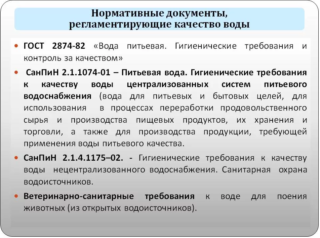 Provisions for providing citizens with drinking water are set out in SanPiN 2.1.4.1074-01 “Drinking water. Hygienic requirements ... ". All procedures for the preparation and operation of the water supply system must be carried out strictly according to the standards.
Provisions for providing citizens with drinking water are set out in SanPiN 2.1.4.1074-01 “Drinking water. Hygienic requirements ... ". All procedures for the preparation and operation of the water supply system must be carried out strictly according to the standards.
Dangerous viral, zoonotic and infectious pathogens, helminth eggs and biohelminths can be in water bodies. In some regions, excess or lack of minerals in the soil leads to endemic diseases. Due to the ingress of toxic industrial effluents into water sources, chronic intoxication of people is possible. Compliance with hygiene requirements of SanPiN and quality control of drinking water ensures a safe water supply.
Scope and General Provisions
SanPiN of centralized drinking water supply refers to the activities of organizations and individual entrepreneurs supplying settlements with drinking water, performing design work, construction and operation of water supply systems. Government agencies use standards for sanitary and epidemiological control. SanPiN requirements relate to the water supply of the population, plants involved in the processing of food raw materials, the manufacture or storage of food products, to trade organizations, to other industries that require drinking water of quality.
According to SanPiN, the quality of centralized water supply should be strictly controlled in accordance with the standards. If laboratory samples are inconsistent, in situations that worsen water quality, and other deviations, companies should immediately report this to the sanitary and epidemiological station and begin to eliminate the violations.
If the consequences of natural disasters and serious accidents cannot be quickly eliminated, temporary deviations from the given chemical composition are possible, coordinated with sanitary and epidemiological surveillance. In this case, several conditions must be met:
- the population cannot be provided with water by other means;
- deviations introduced for a limited period of time;
- the terms of violation of standards are reduced as much as possible;
- lack of threats to the health of citizens;
- informing the public about the quality of water, introduced deviations, their duration and possible health risks.
According to SanPiN, centralized water supply can be suspended if the causes of the accident are not eliminated, and hygienic characteristics violate the standards. When it is not possible to ensure a safe water supply, the rules require that the use of the water supply system be completely prohibited and that residents be provided with water in other ways.
Sources of centralized water supply
 The following types of sources are used for water supply:
The following types of sources are used for water supply:
- Underground. Interstratal water can be consumed without sanitation. Groundwater does not have an upper waterproof layer, they are much inferior to inter-reservoir sources in terms of hygiene. SanPiN permits their use for water supply only in small towns.
- Open ground sources - rivers, canals, lakes, reservoirs.They require cleaning and additional processing. They are characterized by the presence of suspended particles, increased mineralization, bacterial contamination, seasonal fluctuations in chemicals. Often contaminated with toxic substances.
- Atmospheric sources. Also require disinfection and cleaning. They are characterized by reduced mineralization, high nitrogen, carbon dioxide, oxygen, and bacterial contamination. Their chemical composition depends on air pollution.
According to SanPin, water from centralized water sources is regularly checked for compliance. To prevent the entry of toxic substances into water sources, increased requirements have been established for the protection of water intake. It is forbidden to have warehouses with pesticides and fuels and lubricants, cemeteries and cattle cemeteries in the security zone.
Hygiene requirements and regulations
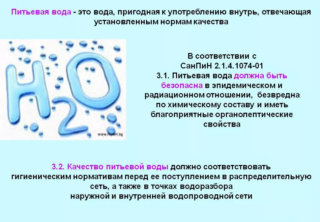 According to the rules, water must be treated and disinfected in the distribution system and all points of the draw-off. Hygienic requirements of SanPiN 2.1.4.1074-01 for water quality in centralized drinking water supply systems are as follows:
According to the rules, water must be treated and disinfected in the distribution system and all points of the draw-off. Hygienic requirements of SanPiN 2.1.4.1074-01 for water quality in centralized drinking water supply systems are as follows:
- harmless chemical composition;
- favorable organoleptic properties;
- epidemiological safety;
- compliance with radiation standards.
The epidemiological component is controlled by parasitological and microbiological samples. The presence of coliform bacteria, cysts of lamblia, coliphages, spores of sulfite-reducing clostridia is not allowed. The total number of microbes is less than 50 in 1 ml of water. Violation of these standards can lead to an epidemiological threat to the population. Therefore, in the field of catering, in hospitals, schools and preschool institutions, supervisory services strictly monitor the quality of water supply.
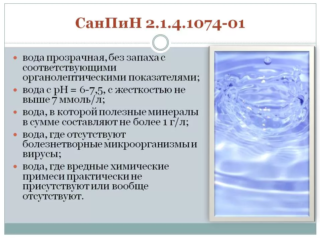 The chemical composition depends on the degree of concentration of hazardous compounds. According to SanPiN, tap water must comply with the following standards:
The chemical composition depends on the degree of concentration of hazardous compounds. According to SanPiN, tap water must comply with the following standards:
- according to generalized indicators, the norm of hydrogen content is not more than 9;
- hardness not higher than 7-10 mmol / dm3;
- oxidizability with permanganate no more than 7;
- dry residue of total salinity up to 1500 g / liter.
Water with a dry residue of 1000 mg / dm3 is considered fresh; more than 1000 mg / dm3 mineralized.
The content of petroleum products, surfactants and phenols should not exceed the standards. The presence of organic substances is unacceptable. Strict level control of extremely hazardous, highly hazardous, hazardous and moderately hazardous inorganic substances.
After treatment with harmful chemicals, the residual chlorine and polyphosphates must be monitored. After chlorination, the level of chloroform is checked, and with ozonation of formaldehyde. Sanitary surveillance in some cases allows you to increase the concentration of chlorine.
Organoleptic characteristics depend on the chemical composition. Water of good quality has a color of at least 20, turbidity up to 1.5-2 mg / dm3, transparency of more than 30 cm. Taste and smell are not felt or are very weak. If they are markedly expressed, this indicates insufficient cleaning. There should be no film or aquatic organisms visible to the naked eye.
Radiation safety is monitored by indicators of total alpha and beta activity, the presence of radon and some radionuclides. For underground sources, as a rule, processing is not required, but radon testing is required.
Quality control of drinking water
 According to SanPin, the drinking water of centralized water supply is controlled by the bodies of the State Sanitary and Epidemiological Service, and the organizations themselves constantly monitor its quality. At the intakes, preventive monitoring is carried out in the form of protection zones of water bodies and monitoring the parameters of intake water.
According to SanPin, the drinking water of centralized water supply is controlled by the bodies of the State Sanitary and Epidemiological Service, and the organizations themselves constantly monitor its quality. At the intakes, preventive monitoring is carried out in the form of protection zones of water bodies and monitoring the parameters of intake water.
Before entering the network, the liquid must be checked for all indicators. Distribution water supply organizations are obliged to conduct regular quality control of drinking water according to SanPiN standards with the following frequency per month:
- when serving up to 10 thousand people - 2 times;
- up to 20 thousand people - 10 times;
- up to 50 thousand people - 30 times;
- up to 100 thousand people - 100 times;
- more than 100 thousand people - 100 + 1 test for every 5 thousand people.
The company must notify the sanitary and epidemiological station about all deviations from the set parameters. For violation of control rules and inconsistency of hygienic characteristics of water, the guilty organization will be fined. Identified violations should be corrected as soon as possible.
Water control is given serious attention. Disinfection and treatment allow the public to supply high-quality tap water and drink it without fear.
